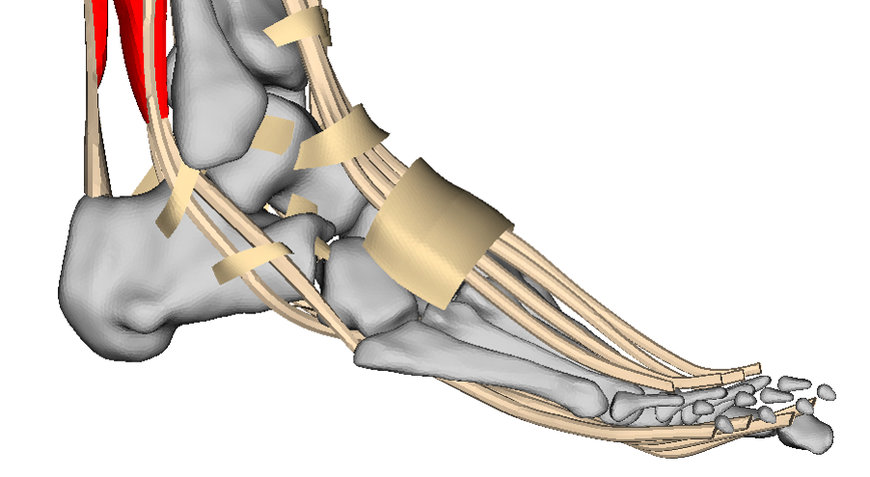www.medical-devices.tech
03
'23
Written on Modified on
Fraunhofer News
TAILOR-MADE IMPLANTS FOR PATIENTS THANKS TO SIMULATIONS USING VIRTUAL HUMAN MODELLING
Researchers at the Fraunhofer Institute for Manufacturing Engineering and Automation IPA have developed a new software platform for virtual clinical in silico studies.

Computer modelling of physiological joint movements — forward-dynamic finite element modelling of the musculoskeletal system © Fraunhofer IPA
Recent studies show that the number of young people with artificial joints is on the rise. There are various reasons for this, including rheumatic diseases, obesity, congenital bone defects and deformities and even damage caused by tumours. Both life expectancy and the desire for mobility are increasing, posing tough challenges for both endoprosthetic and exoprosthetic solutions. With a novel in silico human modelling platform for the research and development of orthopaedic medical devices, the In-Silico Orthopedics research group at Fraunhofer IPA in Stuttgart is tackling these challenges head-on. The group is digitalizing numerous manual production steps and transferring them to a virtual process, making it possible to use the simulation software to manufacture all types of joint replacements, prostheses and orthoses that are tailored to the individual patient in a sustainable, fast and precise way, all while meeting strict quality standards. Among other things, this is supported by one-of-a-kind, individual musculoskeletal human modelling for orthopaedics, generated from medical imaging data from processes such as MRI and ultrasound. The muscle-tendon system is modelled with every possible detail, creating what is essentially a digital twin — a likeness of the patient. With the help of this 3D finite element modelling, the biomechanical characteristics of the muscles, tendons and connective tissue structures can be simulated with realistic physiological dynamic movement both before and after an implant is fitted.
Platform helps surgeons plan operations
Plastic surgery will also benefit from the new solution: Patients with neuromuscular diseases such as cerebral palsy often suffer from muscular dysfunction in their ankle joints. If this can no longer be treated conservatively, ankle joint correction requires a muscle or tendon transfer (e.g., from one toe to another) or tendon lengthening to readjust the delicate muscular balance. The surgeon can test the effects of these interventions prior to operation using the in silico human modelling platform, where they are able to alter various parameters, including geometry, direction, position, load and length.

Human modelling of the outer side of a foot © Fraunhofer IPA
500 patients instead of 50 using virtual clinical studies
Another application for the software platform is virtual clinical trials. Patient-specific analyses of implant functionality and effectiveness are currently hardly ever used in clinical trials as they are too expensive and complex. This is because putting together suitable patient groups, known as cohorts, often proves difficult. It is rare to find more than 50 subjects. However, the new Medical Device Regulation (MDR) now requires the effectiveness of prostheses to be determined. The EU Commission tightened this aspect of the MDR in May 2021.
The recent developments on the in silico human modelling platform will be on display at the joint Fraunhofer booth (Hall 3, Booth E74) at the MEDICA trade show in Düsseldorf from November 13 to 16, 2023. On November 14 (11:30 a.m. – 12 p.m.), Dr. Okan Avci will be taking part in the trade show’s MEDICA TECH FORUM, presenting the topic of “In Silico Orthopedics — Biomechanical engineering of products.”
Recent studies show that the number of young people with artificial joints is on the rise. There are various reasons for this, including rheumatic diseases, obesity, congenital bone defects and deformities and even damage caused by tumours. Both life expectancy and the desire for mobility are increasing, posing tough challenges for both endoprosthetic and exoprosthetic solutions. With a novel in silico human modelling platform for the research and development of orthopaedic medical devices, the In-Silico Orthopedics research group at Fraunhofer IPA in Stuttgart is tackling these challenges head-on. The group is digitalizing numerous manual production steps and transferring them to a virtual process, making it possible to use the simulation software to manufacture all types of joint replacements, prostheses and orthoses that are tailored to the individual patient in a sustainable, fast and precise way, all while meeting strict quality standards. Among other things, this is supported by one-of-a-kind, individual musculoskeletal human modelling for orthopaedics, generated from medical imaging data from processes such as MRI and ultrasound. The muscle-tendon system is modelled with every possible detail, creating what is essentially a digital twin — a likeness of the patient. With the help of this 3D finite element modelling, the biomechanical characteristics of the muscles, tendons and connective tissue structures can be simulated with realistic physiological dynamic movement both before and after an implant is fitted.
Platform helps surgeons plan operations
Plastic surgery will also benefit from the new solution: Patients with neuromuscular diseases such as cerebral palsy often suffer from muscular dysfunction in their ankle joints. If this can no longer be treated conservatively, ankle joint correction requires a muscle or tendon transfer (e.g., from one toe to another) or tendon lengthening to readjust the delicate muscular balance. The surgeon can test the effects of these interventions prior to operation using the in silico human modelling platform, where they are able to alter various parameters, including geometry, direction, position, load and length.

Human modelling of the outer side of a foot © Fraunhofer IPA
500 patients instead of 50 using virtual clinical studies
Another application for the software platform is virtual clinical trials. Patient-specific analyses of implant functionality and effectiveness are currently hardly ever used in clinical trials as they are too expensive and complex. This is because putting together suitable patient groups, known as cohorts, often proves difficult. It is rare to find more than 50 subjects. However, the new Medical Device Regulation (MDR) now requires the effectiveness of prostheses to be determined. The EU Commission tightened this aspect of the MDR in May 2021.
The recent developments on the in silico human modelling platform will be on display at the joint Fraunhofer booth (Hall 3, Booth E74) at the MEDICA trade show in Düsseldorf from November 13 to 16, 2023. On November 14 (11:30 a.m. – 12 p.m.), Dr. Okan Avci will be taking part in the trade show’s MEDICA TECH FORUM, presenting the topic of “In Silico Orthopedics — Biomechanical engineering of products.”
www.fraunhofer.de


